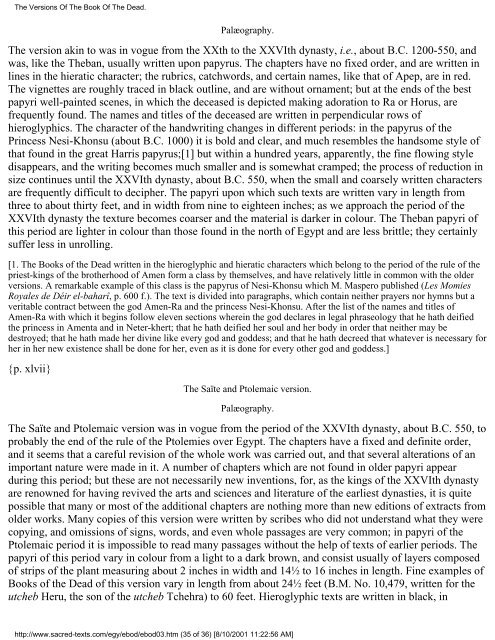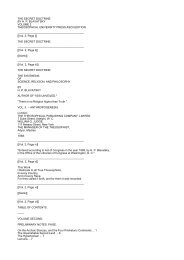Create successful ePaper yourself
Turn your PDF publications into a flip-book with our unique Google optimized e-Paper software.
The Versions Of The <strong>Book</strong> Of The <strong>Dead</strong>.<br />
Palæography.<br />
The version akin to was in vogue from <strong>the</strong> XXth to <strong>the</strong> XXVIth dynasty, i.e., about B.C. 1200-550, and<br />
was, like <strong>the</strong> Theban, usually written upon papyrus. The chapters have no fixed order, and are written in<br />
lines in <strong>the</strong> hieratic character; <strong>the</strong> rubrics, catchwords, and certain names, like that <strong>of</strong> Apep, are in red.<br />
The vignettes are roughly traced in black outline, and are without ornament; but at <strong>the</strong> ends <strong>of</strong> <strong>the</strong> best<br />
papyri well-painted scenes, in which <strong>the</strong> deceased is depicted making adoration to Ra or Horus, are<br />
frequently found. The names and titles <strong>of</strong> <strong>the</strong> deceased are written in perpendicular rows <strong>of</strong><br />
hieroglyphics. The character <strong>of</strong> <strong>the</strong> handwriting changes in different periods: in <strong>the</strong> papyrus <strong>of</strong> <strong>the</strong><br />
Princess Nesi-Khonsu (about B.C. 1000) it is bold and clear, and much resembles <strong>the</strong> handsome style <strong>of</strong><br />
that found in <strong>the</strong> great Harris papyrus;[1] but within a hundred years, apparently, <strong>the</strong> fine flowing style<br />
disappears, and <strong>the</strong> writing becomes much smaller and is somewhat cramped; <strong>the</strong> process <strong>of</strong> reduction in<br />
size continues until <strong>the</strong> XXVIth dynasty, about B.C. 550, when <strong>the</strong> small and coarsely written characters<br />
are frequently difficult to decipher. The papyri upon which such texts are written vary in length from<br />
three to about thirty feet, and in width from nine to eighteen inches; as we approach <strong>the</strong> period <strong>of</strong> <strong>the</strong><br />
XXVIth dynasty <strong>the</strong> texture becomes coarser and <strong>the</strong> material is darker in colour. The Theban papyri <strong>of</strong><br />
this period are lighter in colour than those found in <strong>the</strong> north <strong>of</strong> Egypt and are less brittle; <strong>the</strong>y certainly<br />
suffer less in unrolling.<br />
[1. The <strong>Book</strong>s <strong>of</strong> <strong>the</strong> <strong>Dead</strong> written in <strong>the</strong> hieroglyphic and hieratic characters which belong to <strong>the</strong> period <strong>of</strong> <strong>the</strong> rule <strong>of</strong> <strong>the</strong><br />
priest-kings <strong>of</strong> <strong>the</strong> bro<strong>the</strong>rhood <strong>of</strong> Amen form a class by <strong>the</strong>mselves, and have relatively little in common with <strong>the</strong> older<br />
versions. A remarkable example <strong>of</strong> this class is <strong>the</strong> papyrus <strong>of</strong> Nesi-Khonsu which M. Maspero published (Les Momies<br />
Royales de Déir el-baharî, p. 600 f.). The text is divided into paragraphs, which contain nei<strong>the</strong>r prayers nor hymns but a<br />
veritable contract between <strong>the</strong> god Amen-Ra and <strong>the</strong> princess Nesi-Khonsu. After <strong>the</strong> list <strong>of</strong> <strong>the</strong> names and titles <strong>of</strong><br />
Amen-Ra with which it begins follow eleven sections wherein <strong>the</strong> god declares in legal phraseology that he hath deified<br />
<strong>the</strong> princess in Amenta and in Neter-khert; that he hath deified her soul and her body in order that nei<strong>the</strong>r may be<br />
destroyed; that he hath made her divine like every god and goddess; and that he hath decreed that whatever is necessary for<br />
her in her new existence shall be done for her, even as it is done for every o<strong>the</strong>r god and goddess.]<br />
{p. xlvii}<br />
The Saïte and Ptolemaic version.<br />
Palæography.<br />
The Saïte and Ptolemaic version was in vogue from <strong>the</strong> period <strong>of</strong> <strong>the</strong> XXVIth dynasty, about B.C. 550, to<br />
probably <strong>the</strong> end <strong>of</strong> <strong>the</strong> rule <strong>of</strong> <strong>the</strong> Ptolemies over Egypt. The chapters have a fixed and definite order,<br />
and it seems that a careful revision <strong>of</strong> <strong>the</strong> whole work was carried out, and that several alterations <strong>of</strong> an<br />
important nature were made in it. A number <strong>of</strong> chapters which are not found in older papyri appear<br />
during this period; but <strong>the</strong>se are not necessarily new inventions, for, as <strong>the</strong> kings <strong>of</strong> <strong>the</strong> XXVIth dynasty<br />
are renowned for having revived <strong>the</strong> arts and sciences and literature <strong>of</strong> <strong>the</strong> earliest dynasties, it is quite<br />
possible that many or most <strong>of</strong> <strong>the</strong> additional chapters are nothing more than new editions <strong>of</strong> extracts from<br />
older works. Many copies <strong>of</strong> this version were written by scribes who did not understand what <strong>the</strong>y were<br />
copying, and omissions <strong>of</strong> signs, words, and even whole passages are very common; in papyri <strong>of</strong> <strong>the</strong><br />
Ptolemaic period it is impossible to read many passages without <strong>the</strong> help <strong>of</strong> texts <strong>of</strong> earlier periods. The<br />
papyri <strong>of</strong> this period vary in colour from a light to a dark brown, and consist usually <strong>of</strong> layers composed<br />
<strong>of</strong> strips <strong>of</strong> <strong>the</strong> plant measuring about 2 inches in width and 14½ to 16 inches in length. Fine examples <strong>of</strong><br />
<strong>Book</strong>s <strong>of</strong> <strong>the</strong> <strong>Dead</strong> <strong>of</strong> this version vary in length from about 24½ feet (B.M. No. 10,479, written for <strong>the</strong><br />
utcheb Heru, <strong>the</strong> son <strong>of</strong> <strong>the</strong> utcheb Tchehra) to 60 feet. Hieroglyphic texts are written in black, in<br />
http://www.sacred-texts.com/egy/ebod/ebod03.htm (35 <strong>of</strong> 36) [8/10/2001 11:22:56 AM]

















